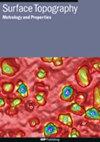基于遗传算法的多深度沟槽织构滑动副润滑性能改进
IF 2
3区 材料科学
Q2 ENGINEERING, MECHANICAL
引用次数: 1
摘要
在轴承的磨损过程中,通过在摩擦表面采用合适的表面纹理,可以有效地降低摩擦副之间的摩擦系数。本研究以表面纹理的分布和深度变化为变量,采用遗传算法进行迭代优化,得到最优的纹理分布和深度。对矩形织构轴承滑块的摩擦磨损性能进行了优化。纹理深度用4位二进制数表示,设置不同的二进制数表示不同的纹理深度。最后,利用遗传算法进行连续迭代进化,得到最优纹理组合。研究表明,与深度为0.2 μm的规则织构相比,深度不均匀的最佳织构摩擦系数降低了15.0%;同时,与常规3 μm深度织构相比,优化后的织构使摩擦系数降低了37.5%,最小油膜厚度增加了0.979 μm。研究得出的最佳织构和油膜厚度组合可以有效减小固体接触力,减轻机械磨损。本文章由计算机程序翻译,如有差异,请以英文原文为准。
Improvement of lubrication performance of sliding pairs with multi-depth groove textures based on genetic algorithm
During the wear and tear process of bearings, the friction coefficient between the friction pairs can be effectively decreased by employing the suitable surface texture on the frition surface. In the study, the distribution and depth variation of the surface texture were used as variables, and the genetic algorithm was used for iterative optimization to obtain the optimal texture distribution and depth. The friction and wear performance of the rectangular texture bearing sliding blocks was optimized. The depth of the texture was represented by a 4-bit binary number, and different binary numbers were set to represent different texture depths. Finally, the genetic algorithm was used for continuous iteration and evolution to obtain the optimal texture combination. The study showed that, compared with the regular texture with a depth of 0.2 μm, the friction coefficient decreased by 15.0% under the optimal texture with a non-uniform depth. Simultaneously, compared with the regular 3 μm deep texture, texture with a optimized depth makes the friction coefficient decreased by 37.5%, and the minimum oil film thickness increased by 0.979 μm. The optimal texture and oil film thickness combination obtained from the study can effectively reduce solid contact force and alleviate mechanical wear.
求助全文
通过发布文献求助,成功后即可免费获取论文全文。
去求助
来源期刊

Surface Topography: Metrology and Properties
Materials Science-Materials Chemistry
CiteScore
4.10
自引率
22.20%
发文量
183
期刊介绍:
An international forum for academics, industrialists and engineers to publish the latest research in surface topography measurement and characterisation, instrumentation development and the properties of surfaces.
 求助内容:
求助内容: 应助结果提醒方式:
应助结果提醒方式:


